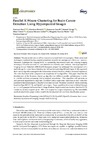Please use this identifier to cite or link to this item:
https://accedacris.ulpgc.es/jspui/handle/10553/43589
| Title: | Parallel K-means clustering for brain cancer detection using hyperspectral images | Authors: | Torti, Emanuele Florimbi, Giordana Castelli, Francesca Ortega, Samuel Fabelo, Himar Callicó, Gustavo Marrero Marrero-Martin, Margarita Leporati, Francesco |
UNESCO Clasification: | 3307 Tecnología electrónica | Keywords: | Algorithm Graphics Processing Units (Gpus) Cuda Openmp Opencl, et al |
Issue Date: | 2018 | Journal: | Electronics (Switzerland) | Abstract: | The precise delineation of brain cancer is a crucial task during surgery. There are several techniques employed during surgical procedures to guide neurosurgeons in the tumor resection. However, hyperspectral imaging (HSI) is a promising non-invasive and non-ionizing imaging technique that could improve and complement the currently used methods. The HypErspectraL Imaging Cancer Detection (HELICoiD) European project has addressed the development of a methodology for tumor tissue detection and delineation exploiting HSI techniques. In this approach, the K-means algorithm emerged in the delimitation of tumor borders, which is of crucial importance. The main drawback is the computational complexity of this algorithm. This paper describes the development of the K-means clustering algorithm on different parallel architectures, in order to provide real-time processing during surgical procedures. This algorithm will generate an unsupervised segmentation map that, combined with a supervised classification map, will offer guidance to the neurosurgeon during the tumor resection task. We present parallel K-means clustering based on OpenMP, CUDA and OpenCL paradigms. These algorithms have been validated through an in-vivo hyperspectral human brain image database. Experimental results show that the CUDA version can achieve a speed-up of ~<inline-formula> <math display="inline"> <semantics> <mrow> <mn>150</mn> <mo>×</mo> </mrow> </semantics> </math> </inline-formula> with respect to a sequential processing. The remarkable result obtained in this paper makes possible the development of a real-time classification system. | URI: | https://accedacris.ulpgc.es/handle/10553/43589 | DOI: | 10.3390/electronics7110283 | Source: | Electronics (Switzerland) [2079-9292],v. 7 (283) |
| Appears in Collections: | Artículos |
SCOPUSTM
Citations
37
checked on Jun 8, 2025
WEB OF SCIENCETM
Citations
28
checked on Jun 8, 2025
Page view(s)
100
checked on May 4, 2024
Download(s)
77
checked on May 4, 2024
Google ScholarTM
Check
Altmetric
Share
Export metadata
Items in accedaCRIS are protected by copyright, with all rights reserved, unless otherwise indicated.
